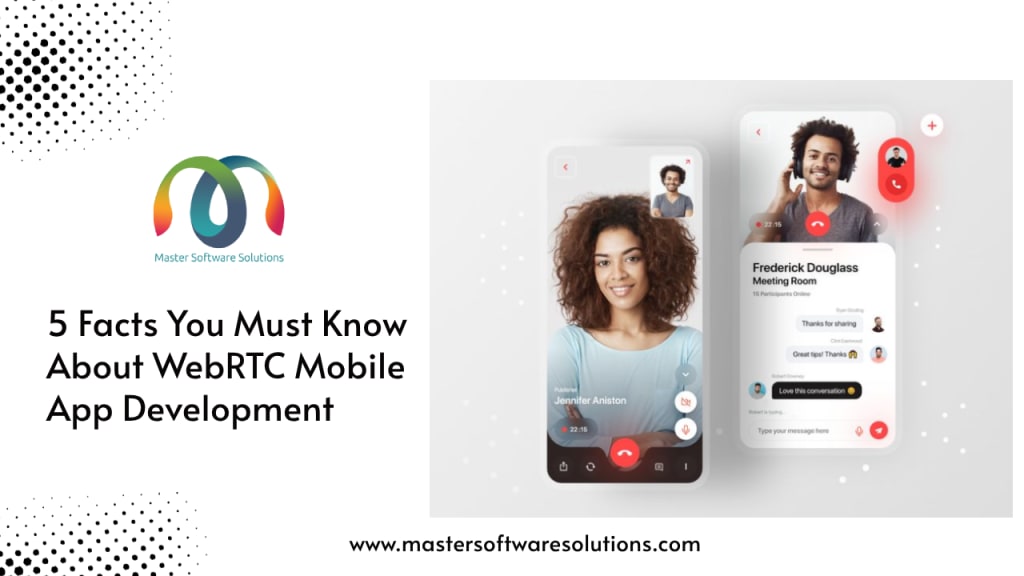5 Facts You Must Know About WebRTC Mobile App Development
Some key insights into WebRTC Mobile App Development

In today's digital landscape, where seamless communication is critical, WebRTC (Web Real-Time Communication) is a game changer. WebRTC, which allows for real-time audio, video, and data sharing in web browsers and mobile applications, has transformed how we connect and collaborate online.
Whether you are an experienced developer looking to improve your skills or a curious newcomer eager to learn more, these insights will help you navigate the complexities of WebRTC mobile app development.
The blog will explore the top 5 facts about WebRTC mobile app development that you must know if you are creating a real-time video chat mobile application.
Understanding WebRTC
WebRTC, or Web Real-Time Communication, is an open-source project that enables real-time communication within web browsers and mobile applications. WebRTC, created by Google, Mozilla, and others, has gained popularity for its ability to enable peer-to-peer audio, video, and data transmission without the need for plugins or additional software.
Popular 5 must-know facts about WebRTC
Understanding these key facts is essential for harnessing the full potential of WebRTC in mobile app development and delivering seamless, secure, and scalable communication solutions to users worldwide.
Here are the top five crucial facts you must know about WebRTC mobile app development:
1. Real-time communication backbone
WebRTC is the foundation for real-time video chat communication in web and mobile applications, enabling peer-to-peer audio, video, and data transmission without the use of third-party plugins or software. Its seamless integration allows developers to create immersive and interactive experiences for users across multiple devices and platforms.
2. Cross-platform compatibility
One of the primary benefits of WebRTC is its inherent cross-platform compatibility. Whether your users are using Android, iOS, Windows, or macOS devices, WebRTC ensures consistent performance and interoperability, enabling seamless communication experiences regardless of device or operating system.
3. Security and privacy
While enabling real-time communication, security and privacy are critical considerations in WebRTC mobile app development. WebRTC uses strong encryption protocols to protect sensitive data and communications, ensuring end-to-end security and user privacy from potential threats or vulnerabilities.
4. Scalability and performance
As mobile applications and user bases expand, ensuring scalability and maintaining peak performance become critical. WebRTC provides scalable solutions with built-in mechanisms for adapting to changing network conditions, ensuring consistent communication experiences even in challenging environments with fluctuating bandwidth or connectivity issues.
5. Community support and ecosystem
The WebRTC ecosystem is home to a vibrant community of developers, contributors, and organizations that drive innovation and push the boundaries of real-time communication technology. Developers can use extensive documentation, libraries, and resources to streamline the custom WebRTC mobile app development process and effectively overcome challenges.
Key components of WebRTC - Real-time Communication
WebRTC is an extremely powerful and versatile technology for developing real-time communication applications on the web and mobile platforms. Developers can use its capabilities to create immersive, interactive, and secure communication experiences that transform how people connect and collaborate online.
- Media Stream (getUserMedia) - WebRTC's getUserMedia API provides access to multimedia devices such as cameras and microphones. This allows developers to capture audio and video streams from user devices, which is an important feature for real-time communication apps.
- RTC Peer Connection - RTC Peer Connection enables peer-to-peer communication by creating a direct connection between browsers or devices. It manages encryption, bandwidth, and network traversal to ensure secure and efficient data transmission.
- RTC Data Channel - In addition to audio and video, WebRTC allows the transmission of arbitrary data via RTCDataChannel. This allows applications to exchange text messages, files, and other data in real-time, broadening the range of communication options.
- Signaling - WebRTC applications require a signaling mechanism to coordinate peer communication. While WebRTC does not specify a signaling protocol, developers frequently use WebSocket, HTTP, or other protocols to exchange session control messages and establish connections.
Key advantages of WebRTC:
- Cross-platform compatibility - WebRTC is compatible with all major web browsers and platforms, including Chrome, Firefox, Safari, and Edge, as well as Android and iOS devices. This ensures broad accessibility and consistent performance for users, regardless of device or browser.
- Low latency and high quality - WebRTC's peer-to-peer architecture and optimized protocols reduce latency while providing high-quality audio, video, and data transmission. This makes it ideal for applications that require real-time interaction, such as video conferencing, live streaming, gaming, or remote collaboration.
- Security and privacy - WebRTC prioritizes security and privacy by using encryption to protect user data and communications. End-to-end encryption ensures that only authorized parties can access transmitted content, thereby increasing trust and confidentiality in communication channels.
- Scalability and flexibility - WebRTC provides scalability and flexibility to accommodate a wide range of use cases and deployment options. Whether it is a small-scale video chat app or a large-scale conferencing platform, WebRTC can scale to meet the needs of various applications and user bases.
- Open standards and community support - As an open-source project, WebRTC benefits from a vibrant community of developers, contributors, and organizations that drive innovation and advance the technology. This collaborative ecosystem encourages the continuous development, standardization, and adoption of WebRTC across industries and applications.
The exploration of the five essential facts outlined reveals that WebRTC is a cornerstone technology, reshaping the way we communicate and collaborate in the digital age. The journey of WebRTC-based mobile app development is about more than just creating applications; it is about connecting people, enabling interactions, and shaping the future of communication technology. With WebRTC as our guide, we embark on a journey of innovation, creativity, and limitless possibilities, poised to reshape how we connect in a rapidly changing digital environment.
If you are looking to hire WebRTC developer that align with your business requirements, contact us and see how we can help you.
About the Creator
Master Software Solutions
Master Software Solutions is an IT service-based company. We are a team of 90+ IT experts with more than 12 years of experience. We provide development and tech-consulting services for platforms, like HubSpot, Salesforce and WebRTC.






Comments
There are no comments for this story
Be the first to respond and start the conversation.